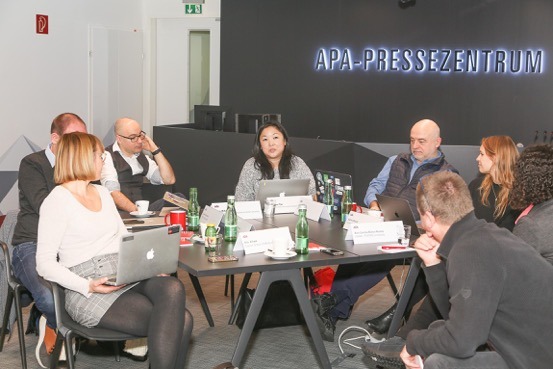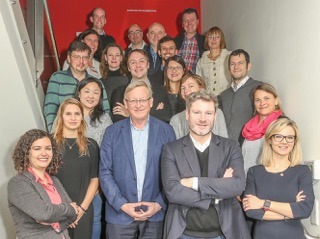Media Lab Days Vienna brought light on innovation experiences and challenges
Over 20 media lab leaders and innovators from around the world participated in the third edition of the event, this time hosted by the Austrian Press Agency (APA) in Vienna.
This edition of Media Lab Days had a different approach to past ones, with a focus on projects rather than lab pitches and an emphasis on workshops and group discussions. Following the visit to APA Media Lab that kicked off the day, Chris Gathercole, Director of the FTLabs, started the series of ten-minute talks with some examples of innovation projects at the Financial Times. He opened with a challenging statement: “Our mission: reporting back from the future”. Chris highlighted the ways we could avoid zombie projects, or those that are kept alive, draining resources, even when they have already failed in the mission they tried to accomplish.
Lina Timm, Founder & Managing Director at the Media Lab Bayern, entered in the discussion presenting learnings from Media Lab Bayern on the application of startup culture to legacy media companies. She warned about the importance of dedicating time to innovation: “100% time job plus 20% innovation time doesn’t work.” In order to fulfil the needs of media business, she presented a part-time media entrepreneurship program developed by the Lab.
The most recent innovation projects from Addendum were presented by Elisabeth Oberndorfer, highlighting their effort on the distribution of audio versions of articles. To conclude the first round of talks, Ana Cecília B. Nunes from Ubilab at PUCRS University in Brazil presented some insights on media lab innovation in the news industry, resulting from a double degree PhD thesis at PUCRS University and University of Beira Interior. The discussion ended with a reflection: “Do we consider media labs as spaces for fostering a new culture of experimentation in journalism and a learning place? Or as an institution that proposes replicable products with a focus on competing in this market?”
 Catching up on new projects, industries and the future of news
Catching up on new projects, industries and the future of news
The second round of presentations started with an automotive industry case. “The car industry will change the media landscape”, says Frédéric Sitterlé, Development Director at Groupe Challenges, in France. He targets cars as a potential content distribution platform and as a new cocoon for premium content, with podcasts and audio among the top products.
Targeting disinformation, Denis Teyssou, from AFP MediaLab R&D presented the brand new project WeVerify. The initiative involves monitoring underground networks, where much of disinformation starts, and is a project financed by Horizon 2020 EU Research and Innovation programme.
And what about the usage of biometric user data to target news consumers? Kim Svendsen kept on the track of the future of news and told the participants about a new experiment at the Stibo Accelerator that he heads in Aarhus, Denmark. He highlighted how emotions such as happiness, sadness, surprise and anger could be used to understand what a reader wants to receive. Furthermore, sleep or the simple information that you have eaten or not could also be part of audience segmentation: “Send a push notification to the smart watch of people within reach of 500 meters who haven’t had lunch yet”.
To finish the new projects session, Noora Alanne, Executive director at the Media Industry Research Foundation of Finland talked about augmented reality through a project from Finland where they connect cities to narratives: “Cities are more than buildings and parks. A city is also its people and its history”.
Getting insights from academic researches
To finish the short presentations, participants enjoyed a connection to the academic world. Nina Springer from Södertörn University in Sweden spoke about immersive journalism, pointing out challenges on its production: accuracy and authenticity, as well as objectivity and professional distance are the main difficulties to target. John Mills from Media Innovation Studio at UCLan in the UK, followed with a discussion on Internet of Journalism Things. He presented a visualization that clustered people’s feelings when consuming news, and revealed prototypes such as the PrinterThing, a device that prints curated content saved through the day to read before bedtime. To conclude, Nadine Strauss, from University of Vienna, finished the series of talks presenting the News-Find-Me concept. It addresses the fact that people don’t search for news as before, but are impacted with it in social media and other channels instead. She highlighted the results of a survey made with social media consumers: “More than half of the respondents have the perception that they do not have to actively follow the news to stay informed”.
 Break Out Sessions closed the event
Break Out Sessions closed the event
Understanding that participants were also looking for new connections, inspiration and wanting to hear about different approaches that might be useful to take back to their labs, the afternoon was dedicated to group discussions. The topics chosen by the participants ranged from monetization and connected cars to cultural change, chat bots and more.
At the end of the afternoon, a whole group discussion closed both the session and the event, which finished with a brainstorm on the next editions of Media Lab Days in 2019.
The Media Lab Days on 2-3 December 2018 in Vienna was the third live event connected to the on-going Media Innovation Mapping project. Read about the 50+ Media Labs we talked to so far or contact us to share your story.
